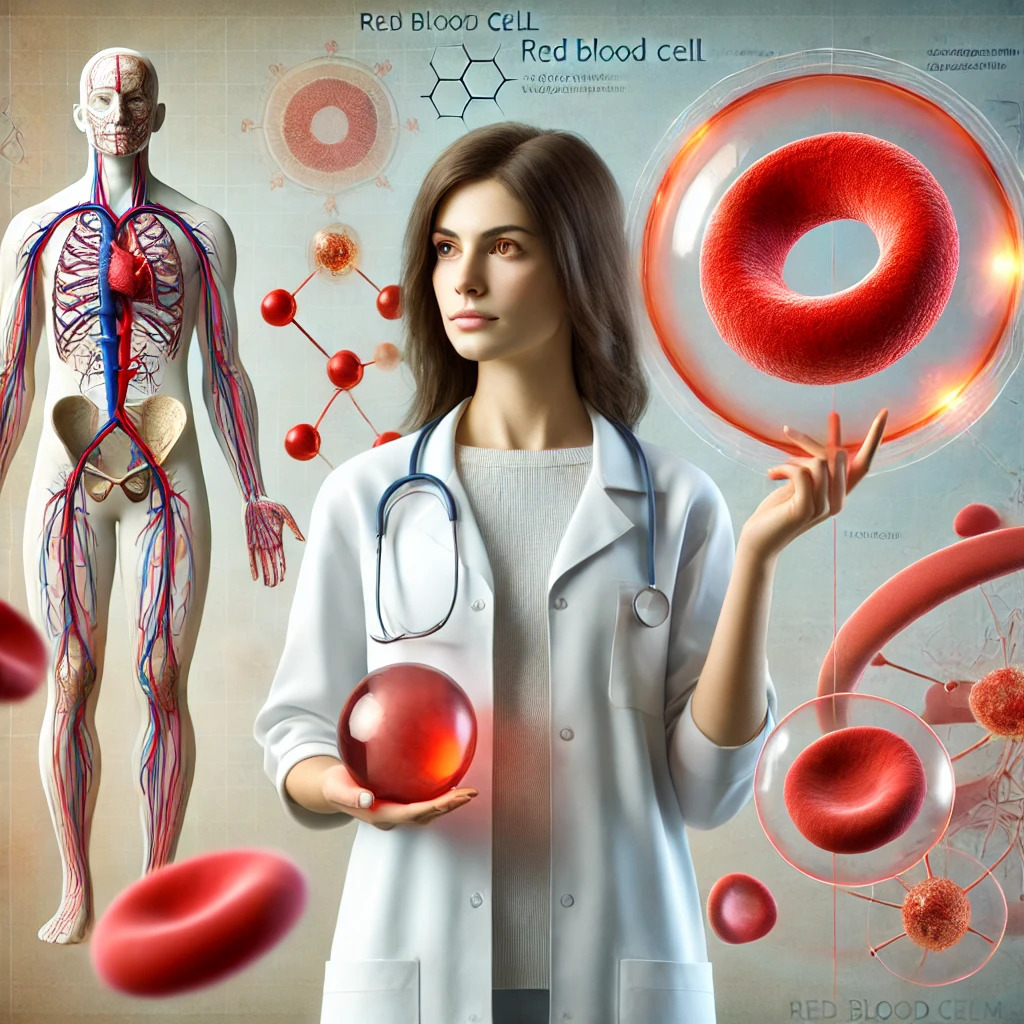Understanding Hemoglobin and Red Blood Cells
-
 Trapti Sharma
Trapti Sharma - 06 Oct, 2024

What Are Red Blood Cells and What Do They Do?
- Red blood cells (also called erythrocytes) are specialized cells responsible for transporting oxygen from your lungs to all parts of your body, and returning carbon dioxide back to your lungs for exhalation.
- Your body produces 2.4 million red blood cells per second to maintain oxygen supply.
- These cells are produced in the bone marrow, primarily in long bones such as your arms and legs.
- Each red blood cell has a lifespan of 100 to 120 days before being broken down and replaced.
- A red blood cell takes approximately 60 seconds to complete a full circuit through your body, starting and ending in the lungs.
- Red blood cells lack a nucleus and DNA, which protects them from being infected by viruses (viruses need DNA to reproduce).
- You have between 20 to 30 trillion red blood cells, making up around 70% of all the cells in your body.
- Red blood cells rely on glucose for energy, as they cannot use ketones, and your body can make glucose through gluconeogenesis (so consuming glucose is not strictly necessary for them).
What is Hemoglobin?
- Hemoglobin is a protein found inside red blood cells, and it is crucial for oxygen transport. Hemoglobin has two main components:
- Heme: Contains iron, which binds to oxygen. This is what gives blood its red color.
- Globin: The protein part, which helps hemoglobin maintain its structure and bind to oxygen efficiently.
- Each red blood cell contains about 270 million hemoglobin molecules, allowing them to carry large amounts of oxygen.
- Hemoglobin’s primary job is to bind to oxygen in the lungs and release it into tissues and organs where it’s needed.
- It also helps transport a small amount of carbon dioxide from tissues back to the lungs for exhalation.
What Happens When You Don’t Have Enough Hemoglobin or Red Blood Cells?
If your body is deficient in red blood cells or hemoglobin (a condition called anemia), you may experience:
- Fatigue: Less oxygen reaches your muscles and organs, making you feel tired.
- Shortness of breath: Your body struggles to get enough oxygen.
- Weakness: Muscles don’t get enough oxygen to function optimally.
How to Strengthen Red Blood Cells and Hemoglobin Levels
You can improve the health of your red blood cells and hemoglobin by ensuring:
- Adequate iron intake (iron is a key component of hemoglobin).
- Sufficient Vitamin B12, which is necessary for red blood cell production.
- Intermittent hypoxia training to stimulate red blood cell production.
What is Intermittent Hypoxia Training?
Intermittent hypoxia training is a practice where you temporarily deprive your body of oxygen in a controlled way, followed by normal breathing. This has been shown to enhance red blood cell production and improve oxygen-carrying capacity. Here’s how it works:
- Intermittent: Done in cycles—alternate between periods of low oxygen intake and normal breathing.
- Hypoxia: This means a state of low oxygen.
How It’s Done:
- Use a hypoxic mask (a mask that reduces oxygen intake) while performing exercises that make you breathe heavily (e.g., cardio exercises).
- Wear the mask for 2 minutes, then remove it for 2 minutes, and repeat this cycle.
Benefits of Intermittent Hypoxia Training:
- Activates genes that enhance the production and size of red blood cells.
- Can increase red blood cell production by up to 10 times, allowing your body to transport more oxygen.
- Stimulates the body’s antioxidant defense systems, protecting cells from damage.
By incorporating intermittent hypoxia training, you can increase your endurance during exercise, improve sleep quality, and potentially experience therapeutic benefits for certain diseases like chronic respiratory or circulatory conditions.
Supporting Hemoglobin and Red Blood Cells with Nutrition
You can support hemoglobin and red blood cell production by consuming:
- Iron-rich foods: These include red meat, spinach, lentils, and fortified cereals. Iron is essential because it forms part of the hemoglobin molecule, helping bind oxygen.
- Vitamin C: This helps improve iron absorption. Include citrus fruits, berries, and bell peppers in your diet to ensure adequate Vitamin C intake.
- Folate and Vitamin B12: Found in leafy greens, liver, and eggs, these vitamins are essential for the formation of red blood cells.
Key Takeaways:
- Red blood cells carry oxygen and are essential for your body’s overall function.
- Hemoglobin, within red blood cells, binds oxygen and transports it to your tissues and organs.
- Red blood cells need iron, B12, and glucose to function properly.
- Intermittent hypoxia training can increase red blood cell production and oxygen-carrying capacity.
- Eating a balanced diet rich in iron, B12, and Vitamin C supports the health of your red blood cells and hemoglobin levels.